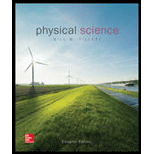
Concept explainers
The science that studies the atmosphere and weather phenomena is
a. astronomy.
b. astrology.
c. meteorology.
d. space science.
The branch of science that studies the atmosphere and weather phenomenon, from the following options:
astronomy.
astrology.
meteorology.
space science.
Answer to Problem 1AC
Solution:
Option (c) is correct.
Explanation of Solution
Introduction:
Meteorology is a branch of science which studies the atmosphere and weather of a planet. It aims at understanding and predicting the nature and state of the atmosphere and the weather phenomenon associated with it.
Explanation:
Reason for the correct option:
Science being a vast subject in itself, there are branches dedicated to studying different ranges of topic. The branch which is exclusively dedicated to studying the atmosphere and weather phenomenon is known as Meteorology.
Hence, option (c) is correct.
Reason for the incorrect options:
Option (a) is incorrect because astronomy is a branch of science which study planets, stars and other celestial bodies and phenomenon associated with them. They are not generally involved in the study of atmosphere and weather of planets.
Option (b) is incorrect because astrology is not considered to be a branch of science and has no scientific validly behind it. It is about studying relative position of celestial bodies and linking them to an even in human life.
Option (d) is incorrect because space science involves the study of outer space, universe and its constituents. Astronomy is a part of space science where they address topics of the like of origin of universe, Big Bang Theory and evolution of the universe.
Hence, options (a), (b) and (d) are incorrect.
Conclusion:
The branch of science which studies the atmosphere and weather phenomenon is known as Meteorology.
Want to see more full solutions like this?
Chapter 22 Solutions
Physical Science
Additional Science Textbook Solutions
Microbiology Fundamentals: A Clinical Approach
Human Anatomy & Physiology (2nd Edition)
Fundamentals Of Thermodynamics
Campbell Essential Biology with Physiology (5th Edition)
Chemistry: An Introduction to General, Organic, and Biological Chemistry (13th Edition)
Campbell Essential Biology (7th Edition)
- Can someone help me with this question. Thanks.arrow_forwardIdentical rays of light enter three transparent blocks composed of different materials. Light slows down upon entering the blocks.arrow_forwardFor single-slit diffraction, calculate the first three values of (the total phase difference between rays from each edge of the slit) that produce subsidiary maxima by a) using the phasor model, b) setting dr = 0, where I is given by, I = Io (sin (10) ². 2arrow_forward
 An Introduction to Physical SciencePhysicsISBN:9781305079137Author:James Shipman, Jerry D. Wilson, Charles A. Higgins, Omar TorresPublisher:Cengage Learning
An Introduction to Physical SciencePhysicsISBN:9781305079137Author:James Shipman, Jerry D. Wilson, Charles A. Higgins, Omar TorresPublisher:Cengage Learning College PhysicsPhysicsISBN:9781938168000Author:Paul Peter Urone, Roger HinrichsPublisher:OpenStax College
College PhysicsPhysicsISBN:9781938168000Author:Paul Peter Urone, Roger HinrichsPublisher:OpenStax College Horizons: Exploring the Universe (MindTap Course ...PhysicsISBN:9781305960961Author:Michael A. Seeds, Dana BackmanPublisher:Cengage Learning
Horizons: Exploring the Universe (MindTap Course ...PhysicsISBN:9781305960961Author:Michael A. Seeds, Dana BackmanPublisher:Cengage Learning
 Physics for Scientists and Engineers: Foundations...PhysicsISBN:9781133939146Author:Katz, Debora M.Publisher:Cengage Learning
Physics for Scientists and Engineers: Foundations...PhysicsISBN:9781133939146Author:Katz, Debora M.Publisher:Cengage Learning College PhysicsPhysicsISBN:9781285737027Author:Raymond A. Serway, Chris VuillePublisher:Cengage Learning
College PhysicsPhysicsISBN:9781285737027Author:Raymond A. Serway, Chris VuillePublisher:Cengage Learning





